Hybrid Cars
Nowadays everybody is talking about the climate change and CO2-emissions. In this context, I decided to not only talk about protecting the environment, but to make a real contribution by buying a Hybrid car in order to reduce at least the CO2 I am causing to be generated when commuting to work every day (using public transport is not am option). Since I'm not inclined to drive around town in - what I consider a bomb waiting to go off (a gas hybrid car) - I opted for an electric hybrid. At the time of writing this article (2007) there were only three choices in Germany when it came to electric hybrids: The Toyota Prius II, the Lexus 400h and the Honda Civic Hybrid. Sadly enough, not a single one of all those legendary German car maker had yet managed to produce a hybrid car! Meanwhile, 6 years later in 2013 there are still no German hybrid cars, apart from the Opel Ampera, which really is a US built Chevy Volt.Because of the price, the Lexus did not make it into my selection. This left with the choice between then Civic and the Prius I thoroughly compared the two cars and found the Civic to be a typical "me too" hybrid. The Prius on the other hand is engineered from ground up to be a hybrid car.
To assess which car suited me best I made a list of features I wanted to have - the result is the following comparison table:
| Desired Feature | Prius II with Hybrid Synergy Drive | Civic with Integrated Motor Assist (IMA) |
|---|---|---|
| Consumption (city/highway/combined) l/ 100 km | 5.0/4.2/4.3 | 5.2/4.3/4.6 |
| CO2 | 104 g/km | 109 g/km |
| Foldable rear seats | Yes | No |
| Luggage Space | 408l / 1210l | 350l |
| Payload | 325kg | 352kg |
| Horsepower Electric/Combustion/Combined | 65/78/110 | 20/95/110 |
| Maximum speed | 170 km/h | 177 km/h |
| Acceleration 0-100km | 10.9 sec. | 12 sec. |
| Electric only mode | Yes | No |
| Cool Technology | Yes | |
| Price in € | 23.900 | 21.900 |
Comparing the data , the Prius proves to be the clear winner. Not only can it run in electric only mode, but its electric motor also has a much higher power than the one in the Civic. The Prius is also much more spacious inside. Looking into the details, the technology of the Civic looks like the one in the old VW Golf Eco which was only built for a short period of time many years ago. Basically, the principle is: an electric motor sits on the same axle with the combustion engine and helps starting it faster than a conventional starter motor. The combustion engine is switched off when the car stops and gets restarted as soon as the accelerator is pushed. Going downhill the electric engine is also used as a generator which recharges the batteries. The Civic uses an automatic gear box.
The heart of the Prius is a small planetary drive (also called Power Split Device - PSD) which couples two electric motors / generators and the combustion engine. There is no clutch whatsoever, nor does the Prius need an additional automatic gear. It is all done by the planetary drive. The onboard computer controls the distribution of power generated by the three motors and makes sure that the gasoline consumption is as low as possible and that the battery gets charged whenever feasible. To understand how this all works is actually not that easy, but there are some good sources on the web where everything is explained in details:
- Official Information from Toyota
- Another explanation of the PSD by Graham Davis
- The PSD in Prius I / II compared to PSD in Prius III - Attention - serious science coming your way!
- Prius Driving Simulation
- Prius commercial showing the Prius II high tech features
- The German Prius Wiki
- The US Prius Chat
The Prius uses "drive by wire" technology. Braking is done by using the electric motors as generators thus converting kinetic energy into electricity instead of pressing brake pads to a brake disc which simply converts kinetic energy into heat. Only when one hits the brakes very hard a conventional brake system (which the Prius of course still has) kicks in. Similarly, the signals from the accelerator are sent to the engine and the electric motors by wire.
Here is a picture of my Prius - incidentally parked behind its (almost identical) twin.
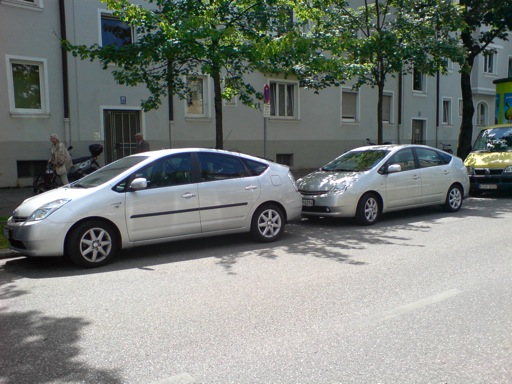
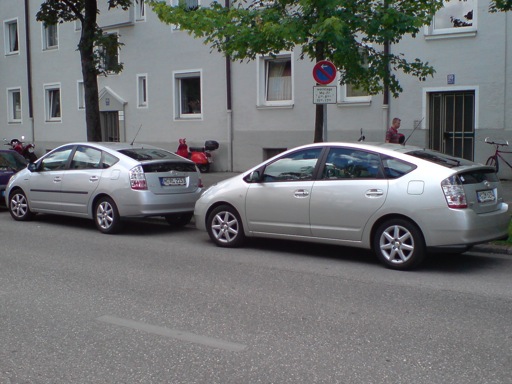
"Cockpit" View - uh oh ... I guess the windshield needs cleaning...

Consumption screen of the onboard computer display.
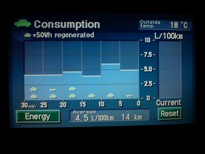 | 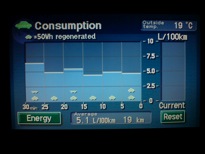 |
| Morning traffic 10km city, 4 km Autobahn | Evening rush hour, heavy traffic, stop & go, 4km Autobahn, 15km city |
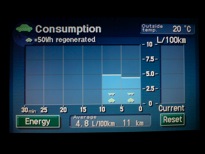 | 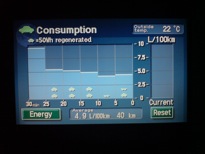 |
| Saturday shopping traffic, several stops at shops | One day of traffic going to work and back. 8km Autobahn, 32km city |
So - what about the most central question: how is it to drive a Prius? Well, it's like using an Apple Computer: just start and go! The Prius is extremely smooth on the road and extremely quiet - this is because the combustion engine is encapsulated and acoustically sealed very well. As you can see from the above pictures, the gasoline consumption is indeed as low as Toyota always claims it to be. Then there are all those other nice features, like the "voice-independent voice-recognition-system". It controls the navigation-, climate- and audio systems. Then there is the keyless entry system, which unlocks the doors as soon as you get near the car.
This is very handy if you have both hands full with purchases (hopefully all environmentally friendly ;-)))))))).
Experiences with the Prius while on a holiday trip throughout Germany: The Prius was loaded with four people and all the luggage we needed for the two week trip. The journey took us from Munich to Bamberg, Dresden, Magdeburg, Berlin, Rostock, Kiel, Hamburg, Hannover and back to Munich. All in all 2819 km. I drove the car mostly on the Autobahn with a speed between 120 and 130 km/h (75 - 80 mph) using Cruise Control. The terrain in Germany is quite hilly so the car had to climb up hills and then could roll down again. Consumption uphill was higher than average, but downhill with the engine being switched off most of the time made up to it. I had to refill the tank of the Prius 4 times with all in all 151 Liters. The calculated average consumption therefore is 5.4 l/100km. Not bad for a fully loaded car!
The other day I drove my Prius 500 km with 300 km on the Autobahn (max speed 130km/h) and 200 km on normal roads (max speed 100 km/h).
Consumption was 4.7l/100 km.
Meanwhile we have two Prius cars in the family. My wife drives the silver Prius II and I drive a new Prius III, 2012 edition. The new Prius had many advances in technology and gasoline consumption.
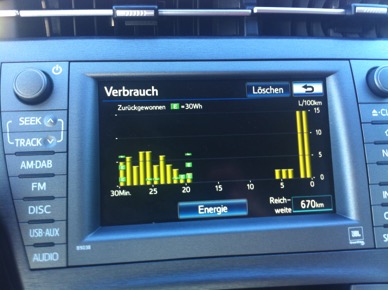 | 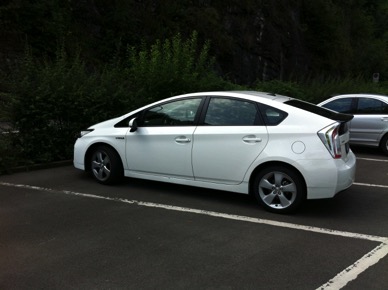 |
| Slow traffic. For 20 Minutes, no CO2 emission at all! Then the battery was empty and the gasoline engine kicked in to charge. |
I lOVE OUR PRIUSes!